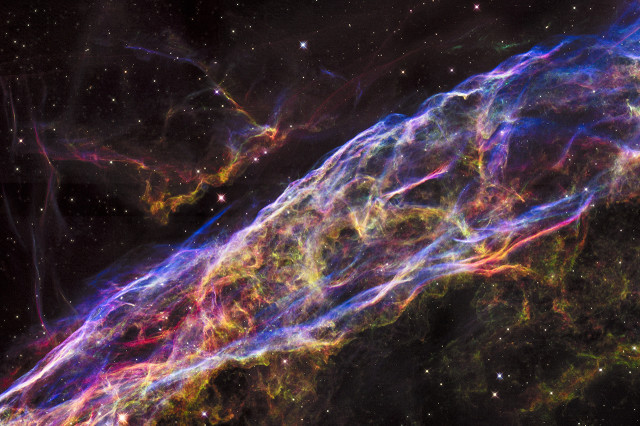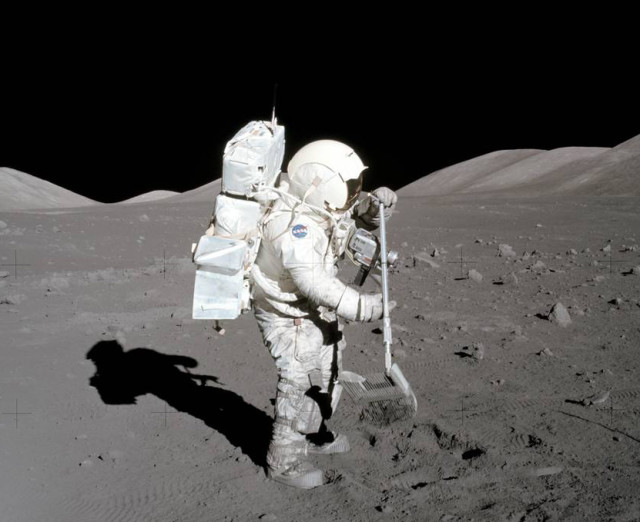Artist Animation of Star Explosion (NASA/JPL/Australian National University)
Two new studies suggest radioactive bits of a nearby star or stars that exploded into a supernova or supernovae showered the Earth and Moon with radioactive iron a couple of million years ago.
Both studies found the stellar evidence in concentrations of an isotope of iron called 60Fe.
In one study, based at the Technical University of Munich, scientists from Germany and the US who found the iron isotopes in samples found on both the lunar surface and the ocean floor say this provides provides evidence that they were produced by the same supernova.
Based on their data the researchers say their findings confirm the star that produced the telltale isotopes was about 300 light years away from us – a relatively close distance – when it exploded about 2 million years ago.

Mosaic image captured by the NASA/ESA Hubble Space Telescope shows a detailed look of the a small section of the Veil Nebula, the remains of a massive star that exploded about 8,000 years ago. (NASA, ESA, and the Hubble Heritage Team (STScI/AURA))
When a star explodes it creates new chemical elements, such as 60Fe, that are then blasted into space.
They say that while the 60Fe isotope is produced almost exclusively by a supernova, it’s also possible that lunar material bombarded with cosmic particles could have also created the radioactive iron.
“But this can only account for a very small portion of the 60Fe found,” said Dr. Gunther Korschinek, physicist at TUM and scientist of the Cluster of Excellence Structure and Origin of the Universe in a press release.
The radioactive iron isotope is said to have a half-life (time it takes a particle to fall to half its original value) of 2.62 million years, which in comparison to the age of the solar system – about 4.6 billion years – is a pretty short time.
The researchers say that because of its half-life it’s doubtful that these isotopes were created when the solar system was formed.
To make their findings the research team analyzed lunar samples, gathered by several of the Apollo missions to the moon in the late 1960’s to early 1970’s with the high-sensitivity accelerator mass spectrometer of the Maier-Leibnitz Laboratory near Munich.
The other study by an international team of scientists led by Dr. Anton Wallner, a nuclear physicist at the Australian National University Research School of Physics and Engineering reveals evidence of not just one but a succession of massive nearby supernova explosions.

Apollo 17 astronaut Harrison H. Schmitt collects samples of lunar rocks and rock chips. Material gathered in this and other Apollo missions revealed presence of radioactive iron isotopes from a supernova explosion. (NASA)
As with the German based study, Wallner and his colleagues found evidence of stellar remains in 120 samples of the 60Fe isotope gathered from the sediment and crust gathered from the bottom of the Pacific, Atlantic and Indian Oceans.
They also found the concentration of 60Fe isotopes were from between 1.7 to 3.2 million years ago and agree that they were produced by a series of supernovae in that were less than 300 light years away.
“We were very surprised that there was debris clearly spread across 1.5 million years,” said Wallner in a press release. “It suggests there were a series of supernovae, one after another.
The researchers said they also found the iron isotopes from a supernova that took place about around eight million years ago.
Wallner points out that the amount of 60Fe isotopes on Earth are about a million to a billion times less than other forms of iron.
The team found that the exploding stars that produced the 60Fe isotopes would have been close enough to Earth to be seen during the day and that they shined with a brightness comparable to the Moon.






















Comments are closed.